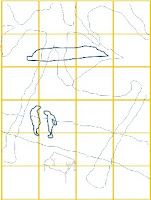Once upon a time, programming, like
painting, was fun. I remembered how I wrote my first program using my 128 steps
programmable calculator and how I went into a flow state quickly.
² Share information with everyone
(whole team listen to user requirements, not just Architect, BA or SA)
² Create autonomy through
boundaries (e.g. Governance, tools, architecture and time-boxing development)
² Replace the old hierarchy with
self-managed teams (team members take up jobs themselves. Tasks are not
assigned)
Moreover, employees’ biggest motivator is
making consistent & meaningful progress (producing demonstrable small
pieces), as concluded in the book “The Progress Principle” (Teresa et al).
 But what happens if we scale further, from a picture to a mural that involve a hundred artists? What if the surface is unknown and need some research to decide on the priming? Behind arts and creations, we do have Engineering - tools, technologies and architectures. For writing, we need to learnt Grammar and for composing songs, we need to understand music theory. If we want to complete the mural as planned, we have no choice but to manage the Engineering portion of it.
But what happens if we scale further, from a picture to a mural that involve a hundred artists? What if the surface is unknown and need some research to decide on the priming? Behind arts and creations, we do have Engineering - tools, technologies and architectures. For writing, we need to learnt Grammar and for composing songs, we need to understand music theory. If we want to complete the mural as planned, we have no choice but to manage the Engineering portion of it.Given the advancement in computing, computer applications nowadays are usually in the scale of huge murals. With more and more mega-projects around the corner, the way we used to program was never be the same again. To manage the sciences behind the scene, the arts & creation portion is partitioned in such a way that it is difficult for us to engage fully, enter the flow state and be highly creative.
The very first divide and conquer method I
have learnt is SSADM. Using tools like DFD and ERD, we analyze the current
physical model to produce the current logical model. We then design the new
logical model and produce the new physical model. We then build and deploy the
new physical design. The next one I have learnt is RUP which provides us a
whole wealth of object-oriented tools and document types. We transit from Business
Modeling, Requirements, Analysis and Design, Implementation, Test and finally
to Deployment. The major difficulty with these two most popular methodologies
is that very often, we rely on the tacit knowledge in our mind to travel back
and forth between analysis, design and construction in order to build the “right”
product. These methodologies don’t allow us to work on an element from end-to-end but force us to deliver explicit knowledge out of tacit
knowledge between stages. These are examples of dividing science and arts together with the same handsaw.

My question is that why a project can’t have multiple tracks? If we divide and conquer properly, the frog can
stay on its own track while each arm of the octopus can has its own track. In
software projects, it is the team structure.
Below is the new team structure for the new V-model in my last post. The unusual part is the breaking up of the traditional
development team into a Business Process team, build team & PMO team. The build
team is artistic in nature especially for the frog. So, it is not hybrid-agile or
Water-SCRUM-fall. Some teams are waterfall all the way through while the build
team is purely agile. I believe that both extending agile by adding waterfall
elements and forcing waterfall to adopt some agile practices are unnatural and unnecessarily
confusing (sort of neither fish nor fowl).
Besides PMO, all teams are following the same
pattern, Specification with measurements (just the measurements, focus in
exploration with users), development work (focus in getting user feedback) and
finally checking the measurements (either manual or automated).
(Refer to the new V-model)
Business Goal Team:
1.
Envisioning and determine measurable business goals, including the
detail measuring methods.
2.
Ensure that “measuring points” are implemented (goal testable).
3.
Drill and accept the measuring process.
4.
Assign measuring resources and define the reporting process.
5.
Final review to determine success
Business Process Team:
1.
Define Business Processes using UML process activity diagrams and
Identify Scenario Steps and decompose into user stories. Prioritize user
stories and agree upon the initial iteration plan. This is the sketch outline
in grids to kick start the Build team.
2.
With the feedbacks from the build team, manage the change to the
Business Processes diagrams and Scenario steps. Perform “test detailing” to
transform it to a detail UAT step-by-step plan with User Guide.
3.
Plan and conduct SIT, UAT and final acceptance.
Build Team:
1.
Paint on its own user story grid with relationships between user stories
defined in Scenario Steps. Frog: all development works are the same.
2.
Explore with users and confirm user story specification as measurements.
3.
SCRUM iteration with immediate user feedback on UI mockup and working
software.
4.
Make the measurements executable (automation) with green lights.
Demonstrate to users and energize the team.
5.
Feedback to Business Process team changes to Business Processes,
Scenario Steps and user stories (add / delete / changed / merged / split).
Technology Team:
1.
Define non-functional requirements (measurements) and testing steps.
2.
Define architecture, tooling, build prototypes and perform
proof-of-concepts.
3.
Produce reference implementations, design patterns and developer
training kits for the Build team.
4.
Specify, build and test common / critical / scientific parts, such as workflows,
cross-cutting security API, those that require regulatory compliance and those
that may endanger human life. Provide API and documents for the build teams to
use.
5.
Hardware procurement, installation, testing, hardening & performance
tuning.
6.
Deployment drills and non-functional test acceptance.
PMO Team:
1.
Overall resources planning. They can be virtual teams and very flexible.
In the extreme, all five teams may be sharing just a few members. For examples,
the build team members can join business process team and technical team initially
and join the PMO team after the last iteration.
2.
Data Conversion planning: data analysis, mapping, confirmation, mocks
& verification.
3.
Cutover planning: existing interfacing analysis, special arrangements,
confirmation, cutover steps & dress rehearsals.
4.
Source code baseline versioning, built and deployment management.
5.
Deliver the living documentations composing of Business Processes
diagrams, Scenario steps with User Guide and Build Team’s user story
measurements.
6.
Operation, Incident management & Support: Produce required operating
manuals and deliver trainings.



















